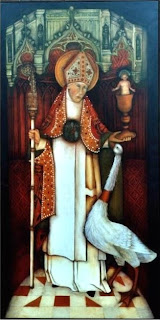
Song on a May Morning
Now the bright morning-star, day's harbinger,
Comes dancing from the east, and leads with her
The flowery May, who from her green lap throws
The yellow cowslip and the pale primrose.
Hail, bounteous May, that dost inspire
Mirth and youth and warm desire!
Woods and groves are thy dressing,
Hill and dale doth boast thy blessing.
Thus we salute thee with our early song,
And welcome thee, and wish thee long.
John Milton (1608-1674)
John Milton's best known work is 'Paradise Lost' but the lovely poem above was written when he was a student at Christ's College in Cambridge.

Over hill, over dale,
Thorough bush, thorough brier,
Over park, over pale,
Thorough flood, thorough fire!
I do wander everywhere,
Swifter than the moon's sphere;
And I serve the Fairy Queen,
To dew her orbs upon the green;
The cowslips tall her pensioners be;
In their gold coats spots you see;
Those be rubies, fairy favours;
In those freckles live their savours;
I must go seek some dewdrops here,
And hang a pearl in every cowslip's ear.
William Shakespeare
These lines are from 'A Midsummer Night's Dream' and are a fairy's reply to Puck when he says 'How now, spirit! whither wander you?' I went to see a performance of Benjamin Britten's opera 'A Midsummer Night's Dream' a few weeks ago and shall stick to watching it as a play in future! The music is, frankly, unbelievably dreary.

Sumer is i-cumin in,
Lhude sing, cuccu!
Groweth sed and bloweth med
And springth the wude nu.
Sing, cuccu!
Sing, cuccu!
Say the words out loud and they will make more sense:) These are the first few lines of the oldest known English part song, it was written in the mid 13th century.I can remember learning to sing it in music lessons at school when I was 12 or 13 years old. (The word 'sing' is used very loosely here!) It's written in Middle English, the language of Geoffrey Chaucer and The Canterbury Tales. In case you're struggling it translates:
Summer is a-coming in,
Loud sing,cuckoo!
Groweth seed and bloweth mead
And springs the wood anew.
Sing, Cuckoo!
Sing, Cuckoo!
Mead means meadow here, not the rather scrummy alcoholic drink made from honey!
Bilbo Baggins and I have been going up on Blacka Moor for our morning walks recently and to my delight I've heard the cuckoo calling almost every day. No matter how many times I hear it I always feel a thrill especially now that it is declining in numbers.


When daisies pied and violets blue
And lady-smocks all silver-white
And cuckoo-buds of yellow hue
Do paint the meadows with delight
William Shakespeare
The lines are from 'Love's Labours Lost' and the photos show the 'daisies pied'. If you click on the second one to enlarge it you can see that the some of the daisies are pink and white which is what makes them 'pied'.

These are Shakespeare's cuckoo-buds better known to us as buttercups.
This could be a much longer post, May is such a beautiful month filled with new life - the freshly unfurled leaves on the trees, wildflowers everywhere, fields full of lambs and calves and the air filled with birdsong. It's all there for everyone to enjoy so stop, look and listen before the wheel turns again and the joy and freshness of Spring passes for another year. Other lovely sights and sounds lie ahead but there is nothing quite like the Merrie Month of May.
































